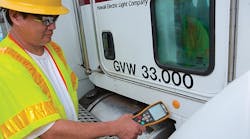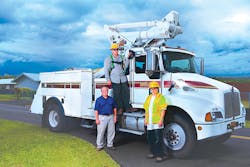For today’s electrical linemen, every minute counts during the work day. When bucket trucks and digger derricks break down, however, a crew’s productivity can be severely compromised.
To help keep its field workforce on the move, Hawaii Electric Light Co. first purchased a GPS telematic system for its fleet seven years ago. At that time, the utility was primarily focused on safety and fuel mileage, but after two years, it started looking for another system that also could provide electronic vehicle inspection reporting.
The utility invested in Zonar Systems’ telematics system, which has simplified vehicle inspections for the field workforce. With the ability to track speeding, idling and low battery, the fleet division can make purchasing decisions that are safe for everyone. Because the system can be integrated with the GPS system, it can be accessed by a wide range of workers — from linemen to the fleet division to contractors — to manage more than 300 different vehicles.
Reporting Issues
Before the utility invested in the Zonar system, linemen typically called their supervisors to report problems with their vehicles. They would then have to arrange for alternate transportation while the repair was scheduled and made.
The linemen also recorded driver vehicle inspection reports in paper books within their trucks, but three years ago, the utility went paperless. Now, by using the digital telematics system, linemen can identify problems before they happen.
Hawaii Electric Light equipped each truck with Zonar’s telematics system, which is about three times the size of a cell phone and can be placed in a cradle mount. This system routinely alerts drivers about defects or fault codes developed by the engine, collects inspection data and then transmits it wirelessly to Zonar’s web-based Ground Traffic Control data management application. Next, Zonar integrates the data into the utility’s fleet maintenance system, called FleetFocus from AssetWorks.
For the system to work effectively, drivers must thoroughly inspect their vehicles both before they leave the base yard and at the end of a work day. Before driving to the job site, a lineman must perform a pre-trip inspection by taking the handheld out of the cradle mount, scanning his or her badge, and then ensuring everything is working properly. If there are no defects or problems, the lineman notes this within the system. After returning to the base yard, the linemen will also perform a post-trip inspection and record the results within the digital system.
The equipment in critical inspection zones features radio-frequency identification tags that help to simplify inspection for the field workforce. Linemen can position the reader near the tags, which contain information about the location of the unit, the components that should be inspected, and the identity of the vehicle or piece of equipment. By pushing a button, the driver can indicate the condition of the components by selecting a description from a predefined list to indicate whether they are safe to operate.
If the driver discovers a problem like an oil leak or a broken brake light, he or she can record that information into the handheld meter. Plugging the unit into the cradle will wirelessly transmit the data to the Zonar server, which will send a message to the fleet division within minutes. After creating a work order, fleet administrators can contact contractors who can either meet the linemen at the job site or wait for them to bring their vehicle to the shop.
Hawaii Electric Light outsources all of its fleet maintenance, repair and detailing work to local contractors. With a shop located only a few minutes from the base yard, linemen can meet the mechanics on the way to or from a job site.
Training the Field Workforce
To roll out the new telematics system and green vehicles to the workforce, Hawaii Electric Light provides its employees with continuous training. For their first five consecutive years at the company, employees must attend a driver improvement program. They must also attend the training every other year thereafter.
During this eight-hour course, the utility prepares its field workforce for incoming technological changes within the fleet. As part of this training, participants learn the difference between driving a hybrid and a conventional fueled truck. Unlike a truck with manual transmission, the internal computer handles the shifting and the clutch. The hybrids also offer more horsepower, which came as a surprise to many of the field crews.
Investing in a Green Fleet
Within the fleet, the utility not only invested in a Zonar system but also focused on standardizing its fleet and integrating more green vehicles.
Back in the 1990s, Hawaii Electric Light had a diverse fleet of vehicles and equipment from different manufacturers. Because of engine, transmission and suspension problems, the fleet had an uptime of about 70% to 75%. By switching to a consistent fleet of Class 7 and 8 trucks, using Kenworth vehicles and equipment, focusing on driver training and integrating technology, the utility increased its uptime to between 96% and 98%. In addition, the utility has managed to increase the fleet’s average fuel mileage from 8.66 mpg to about 25.6 mpg across the fleet.
To boost its fuel efficiency, the utility gradually began purchasing more hybrid, plug-in and electric vehicles. In the 1990s, the utility purchased its first electric vehicles and a few years later, purchased one of the first Toyota Priuses that came to Hawaii. In 2006 and 2007, the utility purchased more of these vehicles, converted them to plug-in hybrids and assigned them to customer service and human resources employees.
For the linemen, Hawaii Electric Light purchased two Kenworth hybrid diesel-electric bucket trucks, which have twice the fuel mileage of the former trucks, and seven Dodge bucket trucks with Altec JEMS48 systems trucks. To fuel the diesel vehicles, the utility began using biodiesel in 2006. As a result, Hawaii Electric Light was able to reduce diesel fuel consumption by 40,000 gallons over four years, despite the annual mileage remaining constant at about 1.7 million miles. Today, 12% of Hawaii Electric Light’s fleet is comprised of hybrid and alternative fuel vehicles including 26 light hybrid vehicles and three electric-powered Nissan Leafs.
By investing in new technology and focusing on driver training and safety, Hawaii Electric Light Co. has decreased operating costs, lowered the vehicle incident rate to 10 per year (or one per 180,000 miles), and increased productivity and efficiency while continuing to make workforce safety its top priority.
Editor’s note: Kelvin Kohatsu, a fleet administrator for Hawaii Electric Light Co. in Hilo, Hawaii, contributed to this article. He has been with the company for 14 years and is responsible for purchasing and writing specs. As a lifelong diesel mechanic, he also handles all the driver training for the bucket trucks, digger derricks and cranes for his company as well as Maui Electric.




